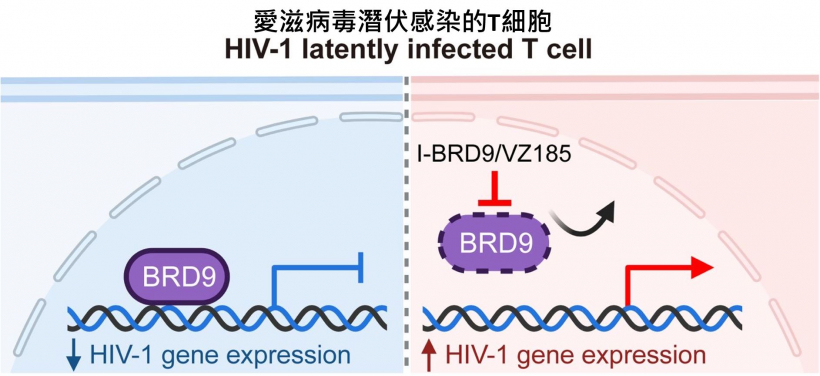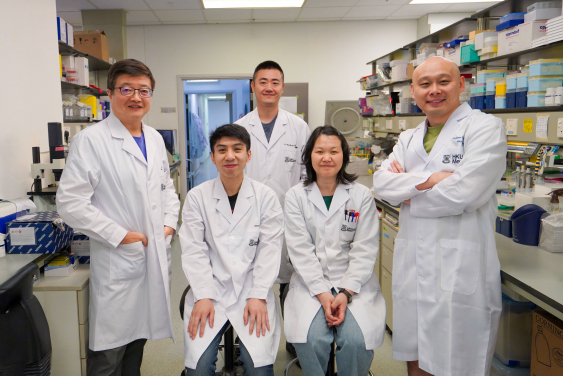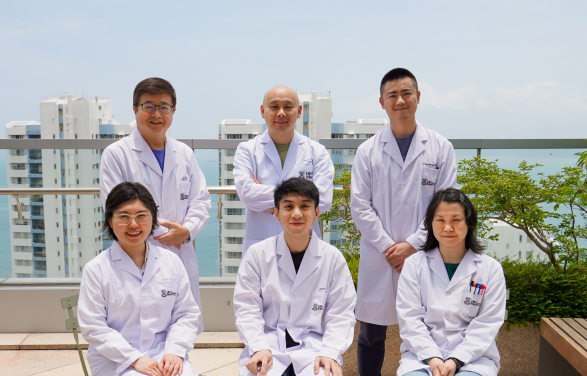Media
HKUMed discovers key protein that enables ‘shock & kill’ strategy for HIV latent virus clearance
11 Jun 2025

The BRD9 protein binds to the HIV-1 virus’s promoter region, helping the virus stay latent. When BRD9 is inhibited or degenerated, the virus becomes active and starts producing more viruses.

A research team led by Professor Chu Hin (first right) and Professor Chen Zhiwei (first left) has discovered that inhibiting the BRD9 protein can effectively reactivate latent HIV-1. When used in combination with other drugs, this approach exhibits significant synergistic effects, offering new hope for the development of novel treatment regimens for HIV-1 cure.

The HKUMed research team has identified a specific genetic transcription factor, BRD9, as a potential key to unlocking the mechanism behind HIV-1 latency. This groundbreaking discovery represents a major advancement in the global effort to combat AIDS.

The BRD9 protein binds to the HIV-1 virus’s promoter region, helping the virus stay latent. When BRD9 is inhibited or degenerated, the virus becomes active and starts producing more viruses.

A research team led by Professor Chu Hin (first right) and Professor Chen Zhiwei (first left) has discovered that inhibiting the BRD9 protein can effectively reactivate latent HIV-1. When used in combination with other drugs, this approach exhibits significant synergistic effects, offering new hope for the development of novel treatment regimens for HIV-1 cure.
- 1 / 3
- 2 / 3
- 3 / 3
Over 40 million people worldwide are living with HIV-1, which continues to be a major global health challenge due to its ability to persist silently within immune cells, evading complete eradication. Researchers at LKS Faculty of Medicine, the University of Hong Kong (HKUMed), have identified a specific gene transcription factor, BRD9, as a potential key to unlocking the mechanisms behind HIV-1 latency. This could pave the way for AIDS to no longer be a largely incurable disease. The study has been published in the scientific journal The Proceedings of the National Academy of Sciences (PNAS) [link to publication].
Despite over four decades of research, AIDS remains a disease that is difficult to cure, primarily due to the highly variable nature of HIV-1 globally. Professor Chen Zhiwei, Suen Chi-Sun Professor in Clinical Science, Chair Professor of Immunology and Immunotherapy, Department of Microbiology, School of Clinical Medicine, HKUMed, and Director of the HKU AIDS Institute, explained, ‘The persistent presence of latent HIV-1 viruses in immune cells remains the greatest barrier to curing AIDS. Even with antiretroviral therapy (ART), many infected individuals still cannot achieve a complete recovery.’
Professor Chen continued, ‘By screening 280 epigenetic compounds, we have identified, for the first time, the BRD9 protein as a key player in reactivating latent HIV-1. BRD9 not only regulates viral gene expression but also competes with the HIV-1 Tat protein, modulating viral reactivation. This discovery offers new hope for the “Shock & Kill” strategy – aiming to activate hidden virus reservoirs and then eliminate them.’
This groundbreaking study reveals that when combined with another HIV-1 latency reversal agent (LRA), the BRD9 inhibitor demonstrates a significant synergistic effect in reactivating latent HIV-1 reservoir.
‘These findings deepen scientific knowledge of HIV latency and lay a crucial foundation for novel curative and precise approaches, offering hope to the millions of people living with HIV worldwide. The strong synergy observed between BRD9 inhibitors and existing LRAs suggests promising avenues for combination treatments to effectively activate and eradicate latent HIV,’ added Professor Chen.
About the research team
The research team is led by Professor Chu Hin, Gallant Ho Outstanding Young Professor, Associate Professor in the Department of Microbiology, School of Clinical Medicine, HKUMed; and Professor Chen Zhiwei, Suen Chi-Sun Professor in Clinical Science, Chair Professor of Immunology and Immunotherapy, Department of Microbiology, School of Clinical Medicine, HKUMed, and Director of the HKU AIDS Institute. The research work was conducted primarily by Dr Luk Tsz-Yat, PhD student, with assistance from several members of the research team, including Professor Yuen Kwok-Yung and Professor Jasper Chan Fuk-Woo of the Department of Microbiology, School of Clinical Medicine, HKUMed.
|
Background The ‘Shock & Kill’ strategy combines LRA with antiretroviral treatment (ART). LRA is used to reactivate latent HIV, prompting infected cells to produce the virus, which can then be targeted and destroyed by ART. Although various LRAs have been developed to manipulate different epigenetic and signalling pathways, none of them can fully activate all latent HIV reservoirs. Clinical trials have shown that despite ART, people living with HIV (PLWH) still harbour replication-competent viral reservoirs. Identifying host factors that control HIV-1 latency and understanding their downstream pathways are critical for developing more effective ‘Shock & Kill’ treatments. |
Media enquiries
Please contact LKS Faculty of Medicine of The University of Hong Kong by email (medmedia@hku.hk).
